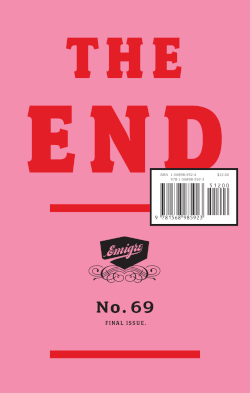Related Research Articles

Emigre, Inc., doing business as Emigre Fonts, is a digital type foundry based in Berkeley, California, that was founded in 1985 by husband-and-wife team Rudy VanderLans and Zuzana Licko. The type foundry grew out of Emigre magazine, a publication founded by VanderLans and two Dutch friends who met in San Francisco, CA in 1984. Note that unlike the word émigré, Emigre is officially spelled without accents.
Tibor George Kalman was an American graphic designer of Hungarian origin, well known for his work as editor-in-chief of Colors magazine.

Emigre was a (mostly) quarterly magazine published from 1984 until 2005 in Berkeley, California, dedicated to visual communication, graphic design, typography, and design criticism. Produced by Rudy VanderLans and Zuzana Licko, Emigre was known for creating some of the first digital layouts and typeface designs. Exposure to Licko's typefaces through the magazine lead to the creation of Emigre Fonts in 1985.
Zuzana Licko is a Slovak-born American type designer and visual artist known for co-founding Emigre Fonts, a digital type foundry in Berkeley, CA. She has designed and produced numerous digital typefaces including the popular Mrs Eaves, Modula, Filosofia, and Matrix. As a corresponding interest she also creates ceramic sculptures and jacquard weavings.
Vaughan Oliver was a British graphic designer based in Epsom, Surrey. Oliver was best known for his work with graphic design studios 23 Envelope and v23. Both studios maintained a close relationship with record label 4AD between 1982 and 1998 and gave distinct visual identities for the 4AD releases by many bands, including Mojave 3, Lush, Cocteau Twins, The Breeders, This Mortal Coil, Pale Saints, Pixies, and Throwing Muses. Oliver also designed record sleeves for such artists as David Sylvian, The Golden Palominos, and Bush.

Michael Bierut is a graphic designer, design critic and educator, who has been a partner at design firm Pentagram since 1990. He designed the logo for Hillary Clinton's 2016 presidential campaign.

Steven Heller is an American art director, journalist, critic, author, and editor who specializes in topics related to graphic design.

Stefan Sagmeister is an Austrian graphic designer, storyteller, and typographer based in New York City. In 1993, Sagmeister founded his company, Sagmeister Inc., to create designs for the music industry. He has designed album covers for Lou Reed, OK Go, The Rolling Stones, David Byrne, Jay Z, Aerosmith, Talking Heads, Brian Eno and Pat Metheny. From 2011 until 2019 he partnered with Jessica Walsh under the name Sagmeister & Walsh Inc.

Eye magazine is a quarterly print magazine on graphic design and visual culture.
Jessica Helfand is a designer, author, and educator. She is a former contributing editor and columnist for Print, Eye and Communications Arts magazine, and founding editor of the website Design Observer. She is Senior Critic at Yale School of Art since 1994, a lecturer in Yale College, and Artist-in-Residence at Yale’s Institute for Network Science. Named the first Henry Wolf Resident in design at the American Academy in Rome in 2010, she is a member of the Alliance Graphique Internationale and the Art Director’s Hall of Fame. In 2013, she won the AIGA medal.
William Drenttel was a designer, author, publisher, social entrepreneur and foundation executive. In 2012, he was the president of Winterhouse Institute, vice president of communications and design for Teach For All, co-director of the Transform Symposium at the Mayo Clinic Center for Innovation, and the recipient of Rockefeller Foundation support to develop models for design and social change. He was president emeritus of AIGA, a fellow of NYU Institute of the Humanities, a senior faculty fellow and social enterprise fellow at Yale School of Management, and the publisher and editorial director of Design Observer, a website covering design, social innovation, urbanism and visual culture. In 2010, Drenttel was elected to the Art Directors Hall of Fame and the Alliance Graphique Internationale, and was the first Henry Wolf Resident in Graphic Design at the American Academy in Rome. He lectured widely in the U.S. and abroad.
Jeffery Keedy, born 1957, is an American graphic designer, type designer, writer and educator. He is notable as an essayist and contributor to books and periodicals on graphic design. He is also notable for the design of Keedy Sans, a typeface acquired in the permanent collection of the Museum of Modern Art in 2011.

Jonathan Barnbrook is a British graphic designer, film maker and typographer. He trained at Saint Martin's School of Art and at the Royal College of Art, both in London.
Design Observer is a website devoted to a range of design topics including graphic design, social innovation, urbanism, popular culture, and criticism. The content of the site includes essays, articles, reviews, blog posts, and peer reviewed scholarship. It is the host of the architecture and urban design publication Places and the podcast Design Matters with Debbie Millman.
Jayme Odgers was an artist, photographer and graphic designer. He was best known for his new wave design and experimental collage photography of the 1980s.
An exhibition curated by Rick Poynor at the Barbican Art Gallery (2004) charting over 40 years of graphic design in the United Kingdom.
Richard Hollis Hon. FRSL is a British graphic designer. He has taught at various art schools, written books, and worked as a printer, as a magazine editor and as a print-production manager. Hollis was elected as an Honorary Fellow of the Royal Society of Literature in 2019.
Alan Aboud is an Irish graphic designer and creative director, from Dublin, Ireland. He was educated at Belvedere College, Dublin from 1974 to 1984 and the National College of Art & Design (NCAD), Dublin where he completed his foundation year and began his degree in graphic design before transferring to Saint Martin's School of Art in London in 1986. He graduated from there in 1989, with a first class honours degree.
Ecco Domani is the brand of an Italian wine company selling in the United States, Canada, and Northern Europe, with marketing and distribution by E & J Gallo Winery. It was founded in 1996 and is led by Fabrizio Gatto. Market Watch named it one of the "hot brands" in 1998. It reportedly produces the top imported Italian pinot grigio in the United States.
Adrian Shaughnessy is a British graphic designer, writer and publisher.
References
- ↑ Poynor, Rick (August 28, 2004). "Rick Poynor: Why design is at the core of 21st-century visual culture". The Guardian– via www.theguardian.com.
- ↑ "Eye Magazine". www.eyemagazine.com. Archived from the original on November 7, 2011.
- ↑ "Eye Magazine | Feature | First Things First Manifesto 2000". www.eyemagazine.com.
- ↑ "Design Observer: Writings on Design + Visual Culture: Design Observer". www.designobserver.com.
- ↑ "Britishcouncil.org". Archived from the original on January 16, 2009.
- ↑ Poynor, Rick. "About this site". David King: Designer, Activist, Visual Historian. Retrieved 25 August 2021.
- ↑ "Why Graphic Culture Matters by Rick Poynor Occasional Papers". Occasional Papers. Retrieved 2023-10-18.